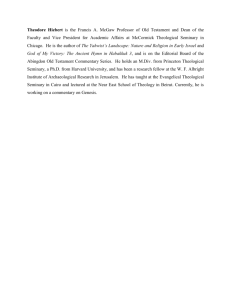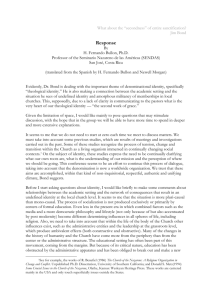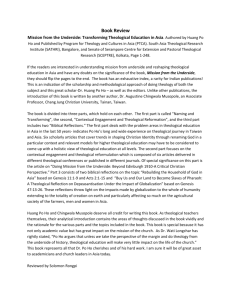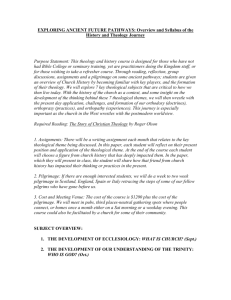Introduction to Curriculum Guidelines
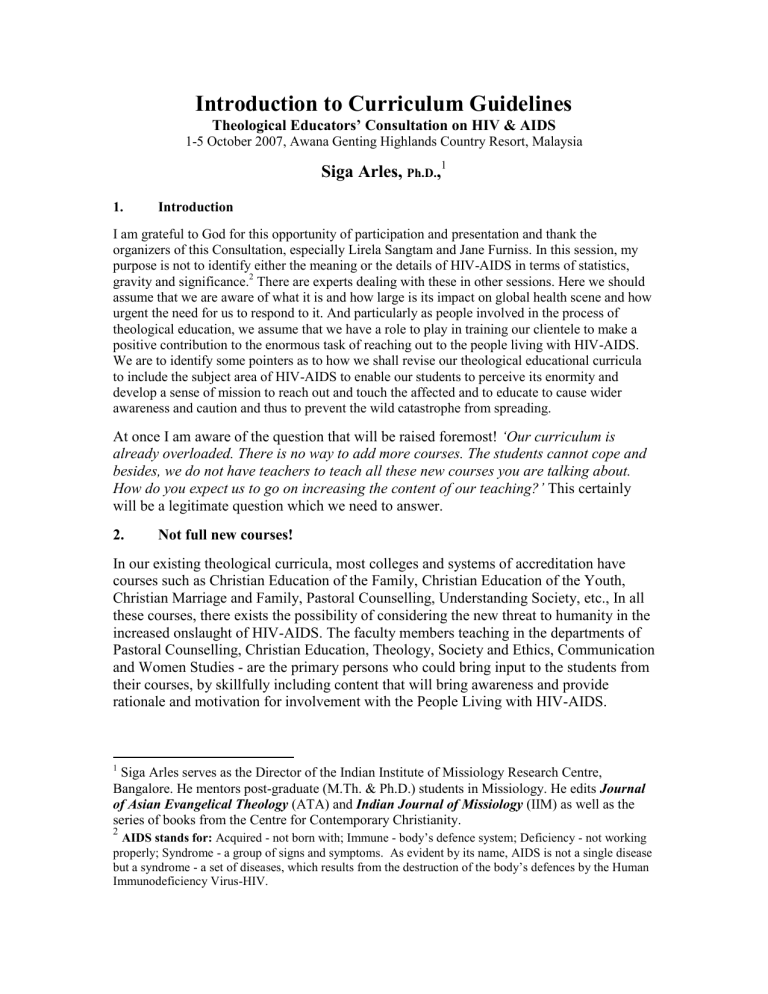
Introduction to Curriculum Guidelines
Theological Educators’ Consultation on HIV & AIDS
1-5 October 2007, Awana Genting Highlands Country Resort, Malaysia
Siga Arles,
Ph.D.
,
1
1. Introduction
I am grateful to God for this opportunity of participation and presentation and thank the organizers of this Consultation, especially Lirela Sangtam and Jane Furniss. In this session, my purpose is not to identify either the meaning or the details of HIV-AIDS in terms of statistics, gravity and significance.
2
There are experts dealing with these in other sessions. Here we should assume that we are aware of what it is and how large is its impact on global health scene and how urgent the need for us to respond to it. And particularly as people involved in the process of theological education, we assume that we have a role to play in training our clientele to make a positive contribution to the enormous task of reaching out to the people living with HIV-AIDS.
We are to identify some pointers as to how we shall revise our theological educational curricula to include the subject area of HIV-AIDS to enable our students to perceive its enormity and develop a sense of mission to reach out and touch the affected and to educate to cause wider awareness and caution and thus to prevent the wild catastrophe from spreading.
At once I am aware of the question that will be raised foremost!
‘Our curriculum is already overloaded. There is no way to add more courses. The students cannot cope and besides, we do not have teachers to teach all these new courses you are talking about.
How do you expect us to go on increasing the content of our teaching?’ This certainly will be a legitimate question which we need to answer.
2. Not full new courses!
In our existing theological curricula, most colleges and systems of accreditation have courses such as Christian Education of the Family, Christian Education of the Youth,
Christian Marriage and Family, Pastoral Counselling, Understanding Society, etc., In all these courses, there exists the possibility of considering the new threat to humanity in the increased onslaught of HIV-AIDS. The faculty members teaching in the departments of
Pastoral Counselling, Christian Education, Theology, Society and Ethics, Communication and Women Studies - are the primary persons who could bring input to the students from their courses, by skillfully including content that will bring awareness and provide rationale and motivation for involvement with the People Living with HIV-AIDS.
1
Siga Arles serves as the Director of the Indian Institute of Missiology Research Centre,
Bangalore. He mentors post-graduate (M.Th. & Ph.D.) students in Missiology. He edits Journal of Asian Evangelical Theology (ATA) and Indian Journal of Missiology (IIM) as well as the series of books from the Centre for Contemporary Christianity.
2
AIDS stands for: Acquired - not born with; Immune - body‟s defence system; Deficiency - not working properly; Syndrome - a group of signs and symptoms. As evident by its name, AIDS is not a single disease but a syndrome - a set of diseases, which results from the destruction of the body‟s defences by the Human
Immunodeficiency Virus-HIV.
3. Train the Teachers!
This at once will imply that the teachers in these departments should be exposed and educated on HIV-AIDS. In the Senate of Serampore College, we recognized the need for it and at the Senate and Board meetings at Aizawl in 2002, we hosted a seminar on HIV-
AIDS.
3
Donald Messer led the seminar accompanied by his colleague. Already the
United Theological College at Bangalore has utilized the expertise of Don Messer in its seminars where students and teachers were enabled to develop a perspective.
4
As quoted in our invitations, Don Messer has skillfully identified:
Silence and stigma are twin killers fueling the global HIV and AIDS pandemic.
Tragically, the churches and theological educators have contributed both to the silence of the Christian community as well as to the stigma that persons living with
HIV and AIDS have experienced. An AIDS-free world will not be possible until every Christian community responds creatively and compassionately to the challenge of AIDS education, prevention, care and treatment. The church will not change until its leaders and theological educators demonstrate a new commitment to the healing ministry of Jesus.
5
Alerting, educating and incorporating the theological teachers – that is the first step. The
Asia Theological Association also had encouraged its member colleges to initiate relevant thinking on these lines. Acts Academy for Higher Education and South Asia
Institute for Advanced Christian Studies, both in Bangalore have organized seminars to enable reflection on HIV-AIDS and the role of theological education.
6
4. Develop a Method to incorporate HIV-AIDS into existing curriculum!
Hence, rather than adding specific new courses and overloading the students, we need to find a way to include this subject area into the existing courses which relate. The process has started. But needs to be furthered and matured. Perhaps in our workshops, we should specifically address this issue – how shall we revise the above mentioned courses and make room for additional input on HIV-AIDS? How shall we equip the teachers? Should we plan for special courses for teachers? Should such courses / workshops / seminars be organized by ATA for all Asia and BTESSC for India, SEAGST and NEAGST for the rest of the Asian nations and ICETE members address them for their eight target areas
7
? Will a ten day workshop during summer or a series of such consecutive workshops in a row for three years help? What will equip the teachers?
3
The author was the Vice Principal of Serampore College at that time and a member of the Senate of
Serampore College.
4
Dr. Nalini Arles, President of the International Council for Pastoral Care and Counselling, is the Head of the Christian Ministry Department at UTC and was involved in conducting these seminars.
5
Quoted in Micah Network invitation to “Theological Educators‟ Consultation on HIV & AIDS” from
Donald Messer, Executive Director, Center for the Church and Global AIDS.
6
Dr. Ken Gnanakan, Dr. Hrangkhuma, Dr. Daniel Premkumar and Dr. Chris Gnanakan were part of the facilitators. See Daniel Premkumar, Ronnie’s Bible: Addressed to People Living with HIV / AIDS,
Chennai: AIDS Desk, National Lutheran Health & Medical Board of UELCI, 2007, pp162.
7
Here I refer to all the theological educational networks that either accredit or affiliate colleges and hold a control over the shaping of theological education. International Council for Evangelical Theological
Education brings together 8 umbrella structures to cover the globe, of which ATA represents Asia.
5. Convince the Theological Education Super Structures!
Micah Network has initiated this gathering but should pass on the baton to existing structures of theological education or at least weld partnership with them, in order to succeed. This is a long process, since the structures are infested with traditionalism. They often speak of being open and flexible, but prove stiff and rigid - „playing safe‟. In our workshops we should identify the ways and means to influence these structures for relevant change in the light of the challenge of HIV-AIDS. There are too many new emphases that call for revision – such as Dalit, Tribal and Feminist Theologies,
Ecological concern, Dialogue… and the latest on the turf is Child Theology.
8
Recognizing the enormous challenge to Theological Education, we should work a rationale and methodology to incorporate HIV-AIDS into our educational curriculum.
6. Not only theoretical input in courses! But Field Exposure!!
Class room input will never suffice if the students were to brave themselves to an involvement. Systematic placement of students to be exposed to centres that are caring for HIV-AIDS and developing regular ministry to them during the period of study ought to be explored. Field Education is of utmost significance. During my time of teaching at
South India Biblical Seminary as well as at Serampore College, it was our practice to send a student each year to a different exposure. Basically, we succeeded to let them have exposure into a church ministry setting, a developmental concern and a counselling based hospital or institutional care ministry. Not every student was turned on by these times of exposure to come back enthused to develop his or her skills with further learning. Often it was an uphill drive to motivate students for compassion and ministry.
In the context of our discussion, we need to open prospects for our staff and students to be exposed to ministries with People Living with HIV-AIDS. My wife Nalini has often taken her students to various such places for practical exposure and involvement in the city of Bangalore where we live. Such institutional links and interactions will enable the students to develop clarity and courage for continued involvements when they move on to their own positions of pastoral and ministerial leaderships.
Hence, in our workshop we need to identify the possibilities of organizing such actual involvements as a weekend or a term break or summer practical field work exposure.
How do we organize such program? How should we develop links with such ministries?
How should we give supervision to it as teachers? What sort of reflection education and further theory input should we evolve? How would we evaluate the growth in our student perspective and its impact on the ‘parachurch’ ‘NGO’ ministries?
7. Not theory or exposure alone! But Genuine Compassion!!
I serve as a Professor of Missiology and many have done their MTh and PhD studies through the years under my supervision. But I have often said that the best student that I have had was T. Raja. He was the driver who served for three years in Karnataka
8
At the initiative of VIVA and Compassion International, there were a series of seminars on developing
Child Theology. It is being shaped. A group has worked out a curriculum for a MDiv level course in Child
Thelogy. ATA India hosted a seminar on it at its Annual General Meeting, 5 September 2007.
Evangelistic Association when I directed its work around Bangalore. Raja was almost an illiterate when he joined us. But soon learned mission and its methods by being with me and seeing all that we did in the fields! He was a fast learner and got into every activity with ease. He learnt to read, to take photo and video, to operate the projector, to give injections and to dress wounds… Soon God drew his eyes to the street / foot path people.
These people who live on the foot paths, sleep on the steps of shops, under the bridges, in the gardens or anywhere… who had no bath or change of clothes for months and years… whose hair is grown rough and wounds have putrified with insects multiplying in them… ill health is spread across their being and they lie as beggars… too tired to call out for attention but wear metal bangles that they rub on the ground to make noise that should draw a passerby to throw some coins…! Raja wanted to help them. To cut the story short, let me say that he founded his own mission – New Ark Mission. He began to take these street people into a shelter which is now known as the Home of Hope. Through the years he has found support from not only Christians and Christian institutions but from all kinds of people – Hindus, Muslims, Secularists, politicians and government officials.
Over 200 inmates live under his roof – fed, clothed, nourished and brought to health and a decent life. Raja picks the street people by his own hands, cuts their hair, dresses their wounds, feeds and nourishes them by his own hands. He shares Christ with them in the middle of all his heavy work. Often there are the „victims of HIV-AIDS‟ that he picks from the streets. Along with all other patients and clients, these also are cared for. One was a young lady who had been misused by many and left mentally deranged. Raja and his team gave her the environment that provided to her the healing of her mind, emotions and body. The story repeats every month as Raja receives street characters brought to him by even the Police Department of the City of Bangalore.
Raja‟s ability to be so very compassionate is a challenge in itself.
9
People have nicknamed him „Mother Theresa of Karnataka‟. We are unable to produce such compassion in our students. Theological Education is blamed as being „elitist‟ and a graduate expects a white collar job and glamourous leadership lifestyle. Teachers are not able to provide a role model of compassion. Despite exposures, students are far from developing an ability to touch, pick and personally minister to the needy. We make preachers out of our students rather than servants. Homiletics is held in priority and not compassionate service. How should we turn this situation around? Any involvement with
People Living with HIV-AIDS would demand ‘compassion’ that is genuine. What would be the methods and means for us to ensure that the students who come to us are steadily enhancing in their capacity for compassion? How shall we revise our curricular and extra curricular input in order that our products would be authentic in touching human need?
At the base of the lack of a ministry to the People Living with HIV-AIDS is the basic
FEAR that dominates people. We are told that this fear is baseless – that it will not infect by hand shake or embrace or dining together or even being close in games and such.
Infection is only by certain limited means of intercourse, exchange of body fluid, injecting with needles which are infected and such. But fear dominates. Compassion is only possible when fearlessness is aroused with rationality. Do we have extra-curricular
9
Videos are available to depict T Raja‟s work at the Home of Hope.
input in our seminary education where students are helped to overcome fears, develop the courage of compassion and burn out with passion for ‘people’?
We overtly spoke of
„souls‟, but now the need is to talk of „people‟. It was easy to theorise and preach in abstract ways to the souls. But the people with bodies need much more than our words.
Ministry must cross over from words to compassionate touch mode, feeling mode, service mode. How would we revise our theological curriculum of elitism to actual human level of service with compassion?
8. Need of the hour: Theological Educators who model their concepts!
„Do as I say‟ is what is often said, implying „do not do as I do‟. Parents want their children to be better than them – even in habits. Teachers teach noble ideas for students to learn, but live far below that nobility. What we may discuss in our workshops could also include some input on how we the theological educators could model for the student the ideas and concepts in our own lifestyle and let them see how we live what we teach.
Perhaps this would be another level of revision that we ought to work on.
Often I had seen plenty little candles - shaped candles and colourful candles at my home.
My wife Nalini likes them and often buys them. These are made by a group of women who are People Living with HIV-AIDS. Sale of these candles is a way to generate some income for them. The leader woman Kanyakumari has come many a times and Nalini used her in seminars and chapel services at United Theological College. There was no fear in Nalini to have this lady in her living room and in her class room and relate with concern. Students have seen this and they derive courage to accept and to work with people whom otherwise they would have shunned in fear. How shall we create such atmosphere of liberty where students could perceive teachers and their lives and learn from their model?
10
9. Personal goal setting – to involve…! That is the starting point!!
„Silence and stigma‟ - the twin killers - as Don Messer puts it. Silence was my own mode when it came to HIV-AIDS. And it still is. But increasingly I am challenged to break my silence and to see prospects for involvement. Personal touch and involvement would be necessary while yet working for curricular revision for what we ought to teach our students. Unless I model it – what I teach shall not amount to much.
The 2002 seminar of the Senate of Serampore was a bit remote to me. Don and Janet were friends of my wife and hence I related with them closely – but could not say I related to the topic of the seminar closely. But seeing the work of Raja with actual people… and seeing my wife‟s involvements with actual „affected people‟ and the care giving ministries, I am challenged to break my silence. And to relate: to relate me; to relate my theological education; and to relate my missiological education to authentic and actual people and situations, including that of People Living with HIV-AIDS.
10
In some colleges there are strict rules that no students should visit the faculty homes! Learning is purely by lectures in classroom and sermons in chapel! There is no room for this modeling in such setting but for rote learning.
Recently I took time to visit a project which meant a lot to me. I was at Olangapo village in the Philippines, 3 hours away from Manila, where the Subic Bay held the US Naval
Base till 1991. The Irish missionary Fr. Shay Cullen directs his PREDA Centre here through which he had developed a rescue mission to children and women caught in the tourism and sex industry.
11
The way he has gone undercover as though a pedophile tourist and investigated what goes on and revealed it to the authorities to fight to liberate the little boys and girls and women; the way he has developed a rescue operation braving attacks on his life; and the way he is arousing a sense of mission from his PREDA
Centre, is something worth discussing in our workshop. He is a brave model for us to consider. I asked him if the Roman Catholic Seminaries of the Philippines were in link with his mission. He said „no‟. I asked if they send their students for field work exposure.
He said „No. Only once a person came. But groups from the West come for internship of a week or a month or two‟. I asked if he was open to receive theological students for exposure and learning. He said „yes‟. He is rather keen that many should come out and take this challenge of rescuing the little children from the enormous evil of sex tourism.
Some of these girls and women arrive as HIV positive. Shay Cullen‟s team works in a mission of advocacy – speaking on behalf of the crushed, broken and helpless.
Work with HIV-AIDS folk will never be easy, it will never stop with theory, but cross over to practice, advocacy and incarnate mission. We are not to talk merely of curricular revision, but of extra-curricular exposures, model setting involvements and embrace of the cross as it stands facing us - to deny fears, to take up the involvement and to follow daily into authentic mission. Let our workshop open prospects for a great change in our mission methods as the pressure of the increasing numbers of People Living with HIV-
AIDS beckons us for involvements.
10. In Conclusion…
In order for us to work towards curriculum revision, throughout this paper I have italicised the kinds of issues and questions I propose for us to discuss. In our workshop let us interact with open minds to see how we can promote those changes and reality in order that theological education that we offer will move the church of the twenty-first century closer to the people where they hurt and move them towards the healing that God in Christ has planned for them. May the Lord use our discussions to speed the process of
„transforming the body of humiliation‟ to „be conformed to the body of his glory‟.
12
11
Fr. Shay Cullen had been in Manila as a Roman Catholic missionary for about 30 years. He sees this as his call to fight for the rights of the children who are exploited. He bravely says he is ready to face the onslaughts of those pedophiles and sex mafia whom he exposes, even if it be false charges, imprisonment and attack on his life. He wishes for many more people to rise to join hands to fight this evil which is a very large reality – sex tourism and exploitation of the poor. His website: www.preda.org
The CNN reports and videos portray the significance of his work. See his concern revealed graphically in this :
We at the Preda Children's Home, have many pending cases of abused children who are seeking healing through justice. Many of the accused are still out there perhaps abusing other children so we are going to hire our own female lawyer and a paralegal officer. Is there a lawyer or paralegal ready to serve the children, it's a well paid job and what better work is there than helping children, the most vulnerable of all. Interested applicants can contact the Preda Center, Olongapo City (09178362274).
12
As Paul indicates in Philippians 3:21.
